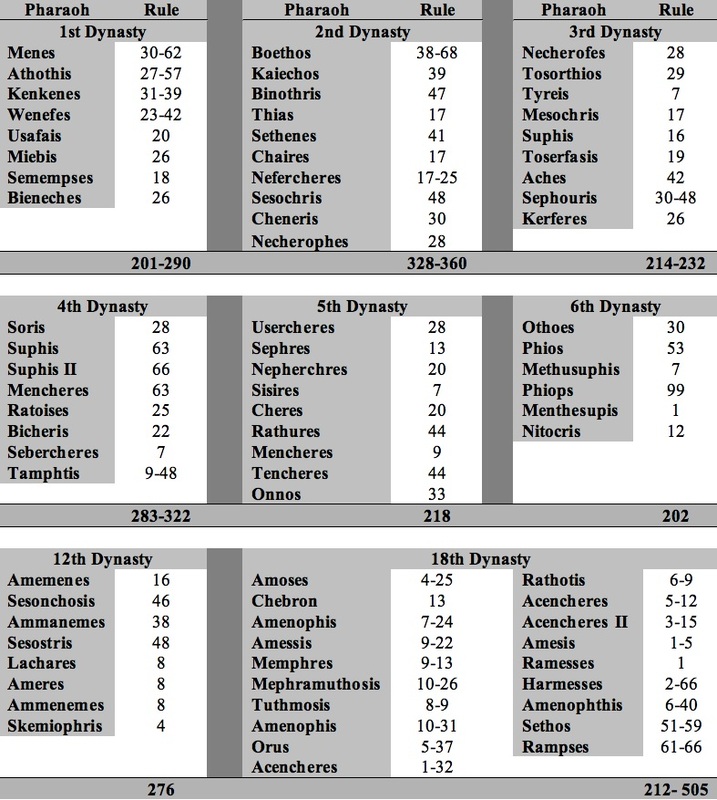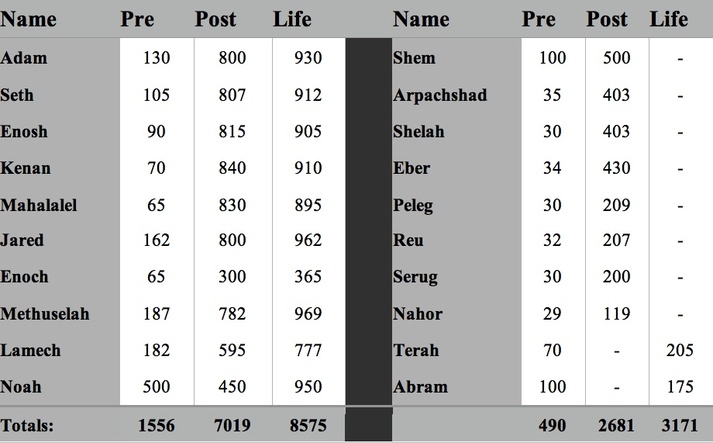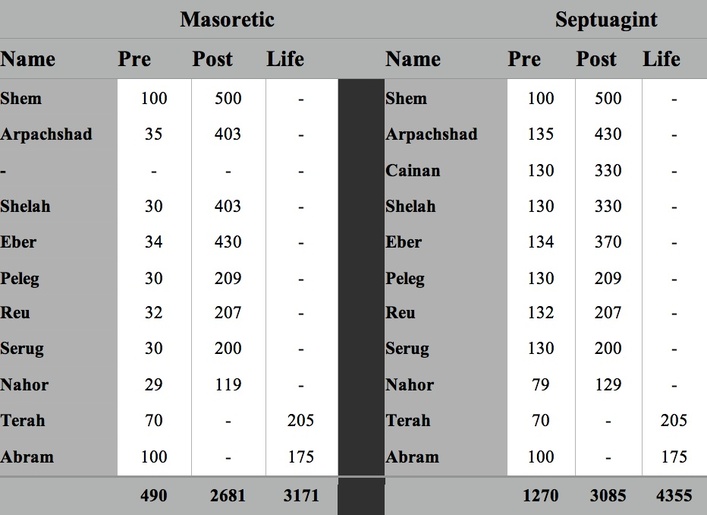Conform Biblical Timeline to Egyptology
We must be willing to apply the same standards of historicity to the Biblical data as the Egyptian data. We must consider the possibility that the traditional understanding may not be what the author intended. If we misunderstand how to read the data in Genesis 11, then of course it will end in historical inaccuracy. Let us assume for this article that Egyptology has the best historical foundation for the earthly timeline. Let us consider what must happen within the text of scripture to comply with this proposed timeline.
One of the attempts to expand the Biblical timeline lies in the interpretation of the numbers themselves. The Septuagint gives different years to each person’s life. They might have had a different copy of the original or a different understanding of what the numbers meant. The numbers in the septuagint are often different. Differences could be due to the language barrier. Is the Masoretic text immune to this problem? Certainly the Hebrew manuscripts are more likely to be understood correctly by those who were closer to the language. But two thousand years pass from Moses’ life until the Masoretic texts. This considered, it is more likely that the Hebrew manuscripts accurately transmit the correct information rather than the Greek translation. But it is possible that both misunderstood how to accurately transmit the numbers. This is not, however, the position of this article.
Assuming the numbers themselves are accurate in our translations, some try to change the interpretation of how to apply them. “Years” may not mean years. Instead of indicating that each person lived hundreds of years, some say that the numbers indicates families or dynasties. Some translate years as generations or an undetermined period of time. This reasoning lacks any real contextual, language, or consistent arguments. Genesis 1 indicates that years are comprised of seasons which are regulated by the sun. The only reason one may try to change the years or numbers is to match other agendas. There is no textual president to doing so.
So if the numbers are accurate and are understood accurately, we must proceed with how to fit the numbers together. There is a textual indication that may support an extended timeline. This is related to the principles of sonship and genealogical gaps. It is textually supported that gaps do occur within many genealogies. This does not indicate inaccuracy. It indicates a different intended meaning. The problem with the basic gaps theory in Genesis 11 is that it applies gaps for no other reason than to match ancient archeological hypothesis. If we are to extend this timeline, it ought not be for human assumption, but for textual purpose.
I believe there are four major indicators that show the traditional interpretation (adding the years together) of the timeline within Genesis 11 is faulty. Again, this does not attack the historical veracity of the Bible. This is a reconsideration of how we understand what the text says.
The first indication that the numbers in Genesis 11 are not intended to be added together is that the author does not add them together. This may seem trite, but it is important. What indicates this as hazardous is the difference to Genesis 5. The pre-flood genealogy takes the first age and adds it to the second age to arrive at the total lifespan of the individual. Genesis 11 does not do so. We are only given the total age of Terah in this genealogy. Did the author forget how to count within six chapters? No, the reason must be purposeful. The intention was not to add the first to the second in Genesis 11. This means there is a fundamental difference in approach. If the lengths of life are not added together, we can make an argument that the ages of all individuals are not supposed to be added either.
The second indication is Luke’s appraisal of the generations. If Luke validates Cainan’s presence between Arpachshad and Shelah then we must come to an understanding other than the traditional. Unless Arpachshad and Cainan both averaged 17 years old, then Shelah would not have been born at Arpachshad’s 35th year. It is possible, but the fact that Genesis 11 doesn’t record Cainan means that the author does not intend to add up all the individuals.
The third and fourth indications are noticed with Noah and Terah. Noah is 500 years old when he “begot Shem, Ham, and Japheth.” The text says Noah entered the ark at 600 years old. This would make Shem 100. The flood lasted a year. But Genesis 11 says that Shem begot Arpachshad at 100 years old two years after the flood. If Arpachshad was born two years after the start of the flood, then Shem would have been born in Noah’s 502nd year. If Arpachshad was born two years after the end of the flood Shem would have been born closer to Noah’s 504th year. So did the author forget how to count again? This begins to pinpoint our misunderstanding.
What is the text intending to say about Noah’s 500th year? If we are consistent with the traditional interpretation of Genesis 11, then Shem, Ham, and Japheth were all three born in the same year. Shem’s name is listed first, but doesn’t have to indicate age. Genesis 10 lists Shem’s family last. Though this may be due to his significance, the genealogies in Genesis tend to provide the genealogies of related persons by age (note: Cain then Seth Gen 4-5; Ismael then Isaac Gen 25; Jacob then Esau because Jacob had birthright and blessing Gen 35-36; sons of Jacob Gen 46.) Is this a case of triplets or does this indicate that Noah’s 500th year does not have to correspond with the birth of Shem?
Terah is a mirror of Noah. He is also the 9th generation in the list, and has three sons. Abram, Haran, and Nahor are all said to have been born in Terah’s 70th year by the traditional reading. Stephen, however, in his commentary in Acts 7 says that Abram left Haran when Terah died. Genesis says Terah died at age 205. Genesis 12 says that Abram was 75 when he departed from Haran. This means Terah must have given birth to Abram at age 130, not 70. How can this be? Again the text implies that Haran is probably the oldest: Haran’s son is listed first and his death is significant to the family structure.
Putting all this together I believe reveals the key to interpreting the Genesis 11 chronology. If the first and last persons in the genealogy follow the same necessary pattern, it is likely that all names between them are subject to the same rules. I believe between Noah’s sons and Terah’s sons we see the implication that the age of the father does not have to correspond to the birth all children, but rather the first born. Noah’s first born was birthed at 500; the others followed. This allows for Shem to be 100, two years after the flood. Terah was 70 when he begot his first born. Abram was not born until Terah was 130. So here is the question. How confident are we that every child in Genesis 11 is the first born? If there is a possibility that the list is not exclusively first borns, then the first age of the fathers do not have to correspond to the child who is mentioned.
This theory makes sense of Noah’s sons, Terah’s sons, and Luke’s addition of Cainan. The post-child years make no difference to the chronology. It is most likely what it appears to be: how long the father lived after begetting that child which shows the theological lesson that sin brings death. But it is possible to pursue other interpretations. As far as the dating system is concerned, this theory opens up hundreds of years. We cannot pursue any specific time table, but could reasonably add as much as a hundred extra years to each generation if necessary.
Adapting the Biblical data to match ancient Egyptology and archeology is possible. If we do so, we must be willing to re-interpret the traditional reading. The post flood years indicate the birth of the first born or, in other words, when they started having children. The child who is mentioned is one of many “sons and daughters,” born at different times.





